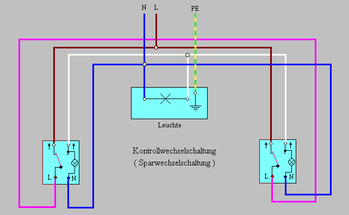Control changeover
The two-way circuit is used in electrical installations to switch “consumers” - usually one or more lights - on and off from two points. In the case of a control changeover , the switches are also provided with a small control lamp such as a glow lamp or light emitting diode , so that the switches can be used to optically see whether the consumer is currently switched on or off. (This is particularly useful if you have no visual contact with the consumer from the switches.)
Layout and function
In terms of wiring, a control changeover circuit is an economy changeover circuit . This differs from a normal two- way circuit in that you need one less wire if you want to install a socket next to the switch. A five-core cable is required to wire an economy two-way circuit with a socket (this is a common commodity). For a common control changeover with sockets, six wires are required on one side.
But you cannot expand an economy changeover circuit to a cross circuit .
For a control changeover, you need either two control changeover switches or two changeover switches that can be retrofitted with control lights (depending on the manufacturer).
If the consumer is switched on - regardless of which of the two switches is used - both control lamps light up. This is achieved by connecting consumers and control lights in parallel .
| Switch position | Consumer and indicator lights |
|
|---|---|---|
| left changer | right changer | |
| Left | Left | out |
| Left | right | a |
| right | Left | a |
| right | right | out |
Control switches are also available with two poles for switching off and with an N terminal as a series control switch .
literature
- Alfred Hösl, Roland Ayx, Hans Werner Busch: The electrical installation in accordance with regulations, residential construction, commercial industry. 18th edition, Hüthig Verlag, Heidelberg, 2003, ISBN 3-7785-2909-9 .
